Papal State

|
The
foundations for the ecclesiastical state were laid by the so-called Pragmatic
Sanction of Emperor Justinian in 554. Then some administrative powers were
delegated to the Pope. The
symbol of this state, which thus did not have a territory or a military
force, was a combination of the Latin and the Greek cross, which in modern
literature is called the “Celtic cross”. A copy of such a cross was donated
to Pope John III by Emperor Justin II in 565. The
Celtic cross is basically found on the territory of the Holy See, the
Patrimony Petri, but also in those areas that can be considered imperceptible
to the Holy See. This was also the area of the Irish Church in
Ireland and Scotland from the 7th century and most Celtic crosses are found
here. Thes crosses became obsolete when the Irish an Scottish churces wer
incorporated into the Roman Catholic Church The
Celtic cross was probably used up to the 13th century, but under the reign of
Innocent III a new symbol for the Papal State appears. In it, the Latin Cross
has been replaced by the crossed keys of St Peter. The arms are identical to
the standard of the time and is later replaced by the arms with the crossed
keys only. A next
phase in the state formation process of the Holy See was the donation of
Pippin the Short who donated some areas in Italy (i.e. Romagna, Pentapolis
and the Exarchate of Ravenna) to the Pope at the so-called “Quierzy Gift”
(754). A number of other areas were added from 757 to 817. For this realm,
Pope Leo III sent the “claves
confessionis sancti Petri ac vexillum Romanæ urbis” to Charlemagne in
796. This “vexillum Romanæ urbis”
is depicted on the apse of the St. John in Laterano. It is green, dotted with
balls in different colors. It apparently included executive powers in the
city and surrounding area.
Pope Leo III and Charlemagne 796 being donated the pallium
and the vexillum Romanæ urbis by St
Peter holding the claves confessionis
sancti Petri. Apse of St. John in Laterano, Rome.
|
||||||||||||||
|
The
oldest supported latin cross is in the Roman catacombs and can be dated ca
350. Here the cross is supported by paschal lambs what may have been the
oldest arrangement symbolizing a christian community.
Ivory reliquiary-case from Samagher (ca 342-44) Museo
Archeologico, Venezia. This side shows in the two upper
registers the achievements of the
imperial adminisration consisting of a square cross supported by 2 ´ 2 eagles, and of the church consisting of a
latin cross supported by two paschal lambs. Below some believers are gathered before the
entrance of the tomb of St. Peter, built under the reign of Constantine the
Great in the old St. Peter in Rome. Nella cassettina d’avorio già a Pola ora al
Correr di Venezia, riconosciuta opera sicuramente romana di committenza
aulica e destinazione ufficiale, datata circa al 440, è convenuto che il
centro del lato anteriore raffiguri l’iconema-fulcro del fascione absidiale
degli antichi mosaici della basilica vaticana, eretta da Costantino sulla
tomba di Pietro e dedicata al Christo in memoria della vittoria al Ponte
Milvio, la cui decorazione ‘figurata’ è ascritta (circa 342-44) al figlio
Costante, in occasione della sua vittoria sui barbari Franchi.
Box of the Canziani Saints. End 4th beginning 5th
cent. 12,4 ´9 cm From Grado,
400ca Latin Cross supported by paschal lambs. In
base four springs symbolizing the four gospels. |
||||||||||||||
|
The Cross and the Angels |
||||||||||||||
|
Column of Arcadius Western side 400-421 AD Latin cross surrounded by a crown of laurel,
supported by two hovering angels
Ivory Diptych, (beginning 6th cent.) Christ seated between St.Peter and St Paul. In the lower register a
latin cross supported by two angels Constantinople, beginning of 6th century Ivory. Coll Martin Le Roy and later Marquet de Vasselot. Major heritage interest acquired in 2003 thanks to the patronage of the Banque de France Cl 23898 Hormisdas 514-523 Johannes I 523-526 |
||||||||||||||
|
Felix IV |
526-530 |
|||||||||||||
|
Basilica San Vitale,
Ravenna. (526-547) Emblem:
Azure a latin cross, hanging therefrom an Ѡ and an A Or, within a
bordure of the rainbow. Supporters:
Two angels hovering |
||||||||||||||
|
Bonifatius II 530-532 *Dioscorus 530 Johannes II 533-535 Agapetus I 535-536 Silverius 536-537 Bonifatius II 530-532 *Dioscorus 530 Johannes II 533-535 Agapetus I 535-536 Silverius 536-537 |
||||||||||||||
|
32 Vigilius |
537-555 |
|||||||||||||
|
|
||||||||||||||
|
33 Pelagius |
555-561 |
|||||||||||||
|
The successor
of Vigilius was Pelagius I, who made resolute use of the pope’s new rights,
organizing the temporal government of the territory over which he was
actually sovereign and setting the papacy on the road to real political
power. This power was to grow so rapidly that Gregory the Great (590-604)
could write, a few years later: “I should like to know whether the pope, in
this world, is a spiritual leader or a temporal king”. [.........] In the latter part of the 6th century the
pope was to be concerned more with vigilance against the danger of barbarian
invasion and with the protection of the peoples of Italy than with his
function as spiritual head of the universal church [.........] At the
invasion of the Longobards, conquering the north (569) the Emperors of
Constantinople could not give much help Yet the emperors persisted in their
claim to be the guardians of the papacy.
Latin cross supported by two angels. On the ground four sources
Syria. 6th
century. Russia. St. Petersburg, The State Hermitage Museum |
||||||||||||||
|
34 Johannes III |
561-574 |
|||||||||||||
|
|
||||||||||||||
|
Cross of Emperor Justin II, 565 |
||||||||||||||
|
Cross of Emperor Justin II, 565 565-570 Cross of Justinus II (565-578) and
Empress Sophia. Tesoro di San Pietro, Roma. Obverse: Imperial
side: A cross set with precious stones, in the middle a medallion with a
Greek cross, surrounded by 12 pearls. On the post the text: X LIGNO YUO
CHRISTUS HUMANUM SUB DIDIT HOSTEM DAT ROMAE. On the cross wood: IUSTINUS OPEM
ET SOCIA DECOREM. Back:
Christ side: The arms decorated with tendrils, in the middle a medallion with
the Paschal Lamb i.e. a nimbled sheep with a cross staff. On the upper arm a
medallion with a Christ with a book nimbed with a Greek cross and a raised
right hand, the palm forward. On the lower arm a mans bust with a Greek
cross, with a codicil (?) In his right hand and a cross staff in his left. On
the right arm an imperial bust with raised hands (orans) and on the left arm an empress bust orans. Four gems are hung on the crossbar. In this form, probably the oldest,
the Cross of Justin II was depicted by
Schema Crucis argenteæ inauratæ Gemmis affabre distinctæ Ex Justini Imp. dono Romam missæ Et in Sacrario Basilicæ Vaticanæ adservatæ Quod nunc primum aere insculptum
editur a Stephano Borgia Sac,. Cong. de
Propag. Fide a Secretis Anno mdcclxxviiii
Grado The patriarchate of Grado came into being
when the schismatic Patriarch of Aquileia, Paulinus (557-569), moved
to Grado in the mid 6th century. But in their reunion
with Rome in 606, a rival office was set up in Old-Aquileia.
Aquileia later entered communion with Rome but was able to keep its
independence and title from Grado. In 1451 the see of Grado was merged
with Castello to form the Roman Catholic Archdiocese of Venice.
Episcopal throne of Grado (606) Latin cross supported by apostles Paul and
Peter. |
||||||||||||||
|
The
Cross and the peacocks |
||||||||||||||
|
Ravenna S. Apollinare Nuovo,
transenna. (3rd
¼ 6th century) Latin cross supported by two peacocks In 552
Ravenna ws recaptured by Byzantium
and Narses became prefect
(552-567). |
||||||||||||||
|
67 Stephanus II
(III) |
752-757 |
|||||||||||||
|
Under Stephen II (III) the course of events
led rapidly toward papal independence from Constantinople. The Lombards took
over most of the Byzantine possessions
in Italy, Ravenna falling in 751. Their aim was now to make Rome the Lombard
capital. Since the emperor Constantine
V could do nothing to prevent them, Stephen II crossed the Alps, the first
pope to do so, and prevailed upon Pepin the Short to come to his assistance
in 754 (when he anointed him as king) or 755 and again in 756. Pepin,
moreover, gave the territories he won from the Lombards to the pope and thus
laid the foundation of the States of the Church; Stephen II was the first
pope to be also a sovereign. The role
of protector of the papacy had passed to the Frankish ruler. Paul I,
Stephens’s brother and successor, informed Pepin of his election, as his
predecessors had informed the emperor, but did not ask for authorization to
be consecrated. 754 Pippin the Short founds the Papal state
Pepijn de Korte by the Donation of Quierzy. “Stephen II was the first pope to
be also a temporal sovereign”. Donation of Pippin, traditional
name of the oral or written promise made by the Carolingian king Pippin III to Pope Stephen II (or III) granting the pope rights over large territories in
central Italy. The Donation was an important step in the
development of the Papal States and helped to solidify the alliance
between the papacy and the Frankish monarchy The Donation
of Pippin came into being as part of the restructuring of political alliances
on the Italian peninsula in the mid-8th century. The papacy, still nominally
subject to the Byzantine emperor in Constantinople, was plagued
by encroachments on its territories from the Lombards, especially under their militaristic king
Aistulf. For protection, Stephen could no longer depend on the emperor, who
had lost control of the imperial capital of Ravenna when Aistulf seized it.
Stephen, therefore, turned his attention northward to the new king of the
Franks, Pippin, who had deposed the last Merovingian king in 750 after gaining approval from
Stephen’s predecessor, Zacharias (741–752). In January 754 Pippin
welcomed Stephen to the Carolingian royal palace at Ponthion, and the pope
remained in the Frankish kingdom throughout the winter. |
||||||||||||||
|
|
||||||||||||||
|
|
||||||||||||||
|
67 Stephanus II (III) |
752-757 |
|||||||||||||
|
750-770 Frontispiece van het
Sacramentarium van Gelasius (Biblioteca Apostolica Vaticana) A Latin cross, in the middle a medallion
with a Paschal Lamb with a cross. The arms are set with nine medallions,
three quarterly of green and gold with a purple cross on its back, and two
quarterly of gold and red with a purple cross. Two others have quadrupeds of
an indefinable type and two others have a rosette. The Greek letters A and Ѡ
hang from the arms.. The cross is ‘supported’ by two peacocks and is under a
canopy, the arch of which is decorated with dragons. At the corners are
eagles. The canopy is supported by two columns, standing on pedestals
decorated with what most resembles four horses. |
||||||||||||||
|
Foto H.d.V. 2016 Achievement
of the Church Müstair Monastery (C.H.),
dendrochronologically dated ca 775 This achievement is of quite a different
program, the peacocks missimg and replaced by the traditional angels Arms: A latin cross, charged with a paschal lamb . Ensigned with a God’s hand Supporters: In chief two angels and in base a cleric (bishop) and an angel with
a crozier This may be the achievement of the
Diocese of Chur. (Dioecesis Curiensis *451 AD- ) to which the monastery was subordinated |
||||||||||||||
|
Page 32v from the Book of Kells. Below
the arch of the ciborium a latin cross
and two peacococks. On the sides woman and a man and below two angels Jaenberht Page 32 v ° in any case does not
represent Christ because at that time, both as head of the church and as a
Pantocrator, he was represented with a nimbus-with-cross. So here we are
dealing with a high prelate, which can also be seen in the book he is
bearing. This prelate is not Pope Hadrian I because he had no beard as can be
seen on some of his portraits. It is also no other pope because he lacks a
pallium. An Irish cleric is all the same because they put the
tonsure on the forehead instead of on the crown. This image is therefore
also a strong argument for the creation in England of the manuscript. It
should therefore be an archbishop of Canterbury under whose spiritual
authority Britain fell. With this prelate something strange is going on,
because he is in the company of two peacocks with a red cross on a white
field on their wrist. The red cross on white is the general symbol of the
Catholic Church or the ecclesia (community of
Christ). However, it is also possible that these crosses were made later
when parts of the page were retouched with white paint. In general, the
peacock can be regarded as the symbol of a prefect or of a high
administrative official. According to Augustine, the peacock was the symbol
of unrepentance because his flesh had not been spoiled even after a
long time. Similarly, "the peacock drives away all vermin with
his screams". For this reason, the co-emperors who considered
themselves to be a prefect, for example from Rome or Gaul, are also
represented with a peacock-tail as a crest. For the theory that the peacocks
are the symbol of a provincial governor or exarch, specially in Ravenna
argues that in this city a number of sarcophagi have been preserved on which
a christogram is depicted supported by two peacocks. The Ravenna
exarchate existed from the end of the 6th century to 750. In 756,
Peppin the Short gave the area of the former exarchate to the
pope, which also became a recognized worldly monarch. In 774 this so-called
“donation of Quierzy” was confirmed by Charlemagne again. [4] The symbol of the Latin cross between
the peacocks after 751 can therefore be considered very well as the symbol of
the pope of Rome resp. of the papal government over a part of Italy. The
image of the prelate in combination with the peacocks could thus mean that he
belonged to the jurisdiction of the church of Rome (which is confirmed by the
red crosses) and under the authority of the pope of the pope i.c. Pope
Hadrian I. fell. In that case the archbishops Jaenberht (765-792) or
Aethelheard (792 / '3-805) can be depicted. Page 32 v ° can therefore, in view
of the date of creation, represent Jaenberht. A woman and a man are
depicted on either side of him. The man has a scepter in his left hand
and thus holds a high administrative position but is not a king because his
nimbus is missing. This corresponds approximately to the position that
Ecgfrith had from 787. Finally, for the woman, either Cynethryth, the
wife of Offa himself, or the wife of Ecgfrith might qualify. |
||||||||||||||
|
80 Leo IV |
847-855 |
|||||||||||||
|
Lastra di rivestimento di altare: pavoni e rosoni
sotto arcatelle forse S. Maria in Aracoeli. Meta secolo IX. Crosses
holding between greek- and latin crosses, supported by peacocks and between eightpointed stars in chief. In
base two double eight-pointed stars (suns). The S. Maria in Aracoeli is a church on the
Capitoline Hill. Museo
dell’Alto Medioevo, Roma [ (medioevo.ostia@arti.beniculturali.it ) Louis the
Pious 834 - † 840/ Lothair I 840-855 |
||||||||||||||
|
109 Johannes XII |
955-964 |
|||||||||||||
|
On his deathbed Alberic II of
Spoleto, ruler of Rome, had Roman nobility and clergy swear they would elect
(his illegitime) son Octavianus as Pope.. This oath was honored in 955
when Octavianus became Pope as Johannes XII
The Privilegium Ottonianum is
depicted and discussed in Das Geheimarchiv des Vatikan (Stuttgart / Zurich,
1992) pp. 60-61. The caption reads:
Purple parchment, 1015 ´ 395 mm,
Carolingian script in gold. A.A., arm. I-XVIII, 18 The document, usually called “Privilegium Ottonianum”, is a copy
from the time of the (lost) original document; with her, Emperor Otto I of
the Roman Church confirmed the gifts of Pippin and Charlemagne on the
occasion of his coronation (by Pope John XII in St. Peter's Basilica on 2
February 962). At the same time, the
document established imperial rights in relation to Rome and in the election
of the Pope after the Constitution of Roman Emperor Lothar in 824. Because of
this “privilege”, the canonically elected Pope had to pledge allegiance to
the Emperor before his ordination and was not allowed to deprive his
officials of imperial sovereignty; this is expressly stated in one of the
most important sections of the document: (Z. 42 ff.: Et ut ille qui ad hoc sanctum et apostolicum regimen
eligitur nemine consentiente consecratus fiat pontifex priusquam talem in
presentia missorum nostrorum vel filii nostri seu universæ generalitatis
faciat promissionem qualem domnus et venerandus spiritalis pater noster Leo
sponte fecissen dinoscitur). |
||||||||||||||
|
113 Johannes XIII |
965-972 |
|||||||||||||
|
John XIII was Otto I's protégé. He
had to come to his aid against the rebellious Romans in 966. John XIII
crowned Otto II co-emperor in 967 and his wife Theophanu co-empress in 972.
In that year, the ciborium in S. Ambrogio must have been created because it
shows Otto I, Otto II, Adelheid and Theophanu. John XIII is on the ciborium
in papal robes with pallium. He is crowned with a cylinder crown by the Hand
of God. This crown must correspond to the secular power that was given to the
Pope by the Privilegium Ottonianum in 962.
Ciborium of the altar S. Ambrogio basilica in
Milaan. South-side: Otto
I († 973), Otto II († 983) and Pope Johannes XIII in the middle. |
||||||||||||||
|
164 Hadrianus IV |
1154-1159 |
|||||||||||||
|
At the coronation of Fredrick Barbarossa by Hadrianus IV there was a
skirmish about the strator service and consequently about the primacy of Emperor
and Pope. A report of that skirmish is in the SS. Quattro Coronati, in Rome.
According to the fresco the skirmish was won by Frederick Barbarossa. Frescoes in the SS. Quattro Coronati, Oratorio di San Silvestro. Rome. This church was built during the
reign of Paschalius II (1099-1118). The frescoes are usually dated to the
early 13th century (1246). The main characters are identified as Emperor
Constantine the Great and Pope Silvester (314-335). [1] It is claimed that the scenes
represent the events surrounding the coronation of Frederik Barbarossa in
1155. Frederick set up camp in Sutri on
Via Cassia in 1155 on the way to Rome expecting to be crowned there. On June
9, Pope Hadrian IV joined him on the assumption that Frederick would render
him the strator service. [2] Frederik categorically refused.
Posing himself for this refusal, Hadrian dismounted and sat down on a
(brought?) throne. Frederick rushed to him, threw himself at his feet and
wished to receive the kiss of peace. Hadrian, however, stated that he could
not give it without Frederick having brought him the traditional tribute. Negotiations were conducted on the
10th. Finally, on 11 June the ceremony
agreed by the princes and cardinals took place not far from Nepi (about 25 km
from Sutri where the Pope had retired). Frederick spent a bit of time with
his army. When the Pope met him, when he saw him, he dismounted and in front
of the whole army led the pope’s ambler a stone's throw by the bridle,
holding the stirrup firmly. Then Hadrian gave Frederick the kiss of peace. In consultation with Hadrian, it
was decided to send a garrison forward to Rome in order to prepare for a
possible revolt by the Roman people against the coronation. It was camped in
the monastery of St. Peter and the surrounding area on the night of 17-18
June. On Saturday, the Pope went into town with the cardinals, followed by
Frederick with his retinue. On the steps of St. Peter's
Frederick took off his clothes and dressed in his coronation robes. He then
proceeded to the church of Mary in Turri, located by the stairs, where the
Pope was staying. Frederick knelt before him, put his hand in that of the
Pope, and here publicly took the oath of coronation, which included, among
other things, his promise to serve the church always. Then the pope, in a
festive procession followed by the king and his men, went to the altar of St.
Peter. At the Church's Silver Gate, Cardinal Bishop of Albano delivered the
first prayer about Frederick. The Cardinal Bishop of Porto spoke the second
prayer at the rota. Before the tomb of Peter, the king threw himself to the
ground and heard the litany. The Cardinal Bishop of Ostia then anointed his
right arm and neck and offered the third prayer. Then Mass was celebrated,
the epistle read and the graduation sung. Then the king approached the pope
and received from his hands the imperial insignia: sword, scepter and the
crown that was put on by the pope. [3] For the time being, it seems that
the fresco tells a slightly different story. The main characters in the
frescoes undoubtedly represent Frederick Barbarossa and Hadrian IV. A
difficulty in their recognition is that the faces on the frescoes are so much
alike. Hadrian's main characteristic is the gray beard and mustache. Frederik
Barbarossa can be recognized by his short, indeed reddish beard. His
portraits are comparable to some other portraits of him from later times. On the left side wall are some
introductory frescoes depicting Frederick's visit to the Holy Land. The most
important act is the overthrowing of the Golden Calf. After that there is
scene which includes the three crosses on Mount Golgotha. Subsequently, a
scene has disappeared. Then 5 scenes follow depicting king Frederick
Barbarossa going to his coronatian and
meeting Hadrian IV. The scenes 6 and 7 are about the strator service:
|
||||||||||||||
|
189 Nicholas IV |
1288-1292 |
|||||||||||||
|
Mosaic in the apse of S. Giovanni in Laterano, Rome. Latin cross, crested of the Holy
Spirit and supported by two deer
As far as the program is
concerned, the central image may date from the 5th century, the head of the
man above the cross is then of Emperor John (423-425). The deer refer to the
patriarch, in which case it is Celestinus I (422-432). The depictions of Mary
and John may have been added later in the 8th century, following the example
of the portraits of Leo IV and Irene in Hagia Sophia in Constantinople. Thus,
the central section would symbolize the Ecclesia, i.e. the Church of the Patriarch
(of Rome) in the 5th century. The question now is why Nicholas IV revived
this way of presenting the Ecclesia.
|
||||||||||||||
|
THE ROMAN CATHOLIC CHURCH (ECCLESIA ROMANA) The schism of 1054 announced
itself at an early stage. Initially, the symbol of the Church of Rome was the
Latin cross supported by the apostles Paul and Peter, where Paul is
characterized by his credentials (codicil)
and Peter by the keys he holds. Later, the two apostles are reduced to the
two keys that are the symbol of Peter alone, so the Latin cross occurs
between two keys. These two keys, always placed in parallel, eventually
became the symbol of the Church of Rome, also known as the Church of St.
Peter, in the 13th century. The parallel keys appear, perhaps for the first
time, on the absism mosaic of ancient St. Peter's in Rome. It features a
symbol of the Church of Rome composed of the throne, the cushion and the
Lamb, replacing the apostles with a depiction of Pope Innocent III (1198-1216)
and Roman King Otto IV holding a red banner on which the two parallel keys
are mounted. In fact, this composite symbol represents the church by the
grace of the emperor and pope, whereby the apostles are thus assigned a minor
role. The arrangement can thus be considered as the continuation of the
arrangement with the Latin cross and angels. It may therefore have been
compounded in the euphoria of the consequences of the 4th Crusade Byzantium
had submitted to Rome and was expected to reunite the churches. However, no
new similar arrangements will occur afterwards. On the contrary, a coin of
Charles of Anjou bearing two parallel keys may indicate that the church
exists by the grace of the king of Sicily. Later, the mandate of the church
remains in the middle because arrangements with two parallel keys from the
14th century are not known. However, the even keys, blue with red cords on a
white shield, occur in the 15th century, possibly as a symbol of the curia. Finally, the series concludes
with the arrangement that Virgil Solis signed in 1555. This is a coat of arms
with two blue parallel keys above which are the tiara and the crossed keys of
the Pope. In this composition of arms a great place is therefore given for
the authority of the pope, as successor of Peter, in the church.
1007-1012 Coronation of the royal couple by Christ
and underneath the honoring by the subject nations Book of Liturgies of Henry II (1002-’14/24).
Reichenau, 1007-’12. From the Treasury of Bamberg Cathedral. Bayer.
Staatsbibliothek München, Cod lat. 4452, fol. 2 r. L.: tractando iustum
discernite semper honestv utile conveniat consultum legis ut optat. Below:
solvimus ecce tibi rex censum iure perenni clemens
es totuis nos reddimus ista quot annis. The central figure below with an orb and
sceptre, the one on the left with a crown of laurel and the one on the right
with a white sphere with a red cross. The first instance of a Pope presenting a specially blessed flag to be
brone in a military expedition of which he wanted to mark his approval is
saidto be that of Benedict IX in 1044, in the case of the campaign of Emperor
Henry III against the pagan reaction in Hungary. Galbreath p. 2 ff Later, several specially blessed
flags are presnted by the Pope but these are most certainly flags of the
western church and they were white with a red cross. In the 11th century, a banner with
a red cross appears on a white cloth as vexillum
S. Petri. This has probably already been used by the first vexillifer William of Montreuil (1059)
and then by his successors. [4]
The ducal vessel at the campaign of Hastings, 1066. Bayeux tapestry
scene 38 Ensigned with a cross at the main
and a lion’s head for figurehead.
The duke’s flag Bayeur tapestry
scene 55 A cross between four balls, marks
of his ducal / admiral’s rank. We learn from the 1st crusade that
the troops fought under the “banner of St. Peter”. This is reported by Anna
Komnena: Hugues of Vermandois announced his arrival during the 1st Crusade in
a letter to Emperor Alexios I. Arriving in Lombardy he sent John, son of the sebastokrator Isaac (brother of
Alexios) and then Duke of Dyrrachium (= Dürres) “ambassadors from there [to
the Duke of Dyrrachium], twenty-four in number, protected with cuirasses and
greaves of gold, together with the Count Tzerpenterius (Charpentier?) And
Elias who had deserted from the Emperor at Thessalonica. They spoke as
follows to the Duke, “Be it known to thee, Duke, that our Lord Ubus (= Hugo)
is on the point of arriving, and is bringing with him from Rome the golden
standard of Saint Peter. Understand, too, that he is the leader of the whole
Frankish army .... ”. Unfortunately, this "standard of St. Peter"
is not further described. [5]
In a rebellion in Milan supported
by the Roman clergy, their leader, Erembald, was given a special blessed
banner by Pope Alexander II (1061-'73): “In
publico consistorio vexillum S. Petri Herembaldo dedit eumque Romanæ et
Universæ Ecclesiæ vexilliferum fecit ”. [6] In a letter from the Milanese to
the citizens of Tortona from 1155, it is described as “Album vexillum cum cruce D.N.J.C. rubeum colorem habens ” and it
would be inferred from this that the cross was a Latin cross. [7]
Thereafter the flag of the church,
a red cross on a white cloth is borne by several papal vassals such as
England and France A banner more specifically of the
Papal state was displayed by Emperor Otto IV at the beginning of the 13th
centuryy |
||||||||||||||
|
In the memorable document […] the
content being conjured up by him (= Otto IV) on the day of his election, 9
June 1198. For he unreservedly recognized not only the rights of the Church
to the patrimony and the estate of Countess Mathilde, but also her alleged
rights to all those central Italian imperial lands in which she had
endeavored to assert her sovereignty since the Emperor's death. He gave the
exarchate of Ravenna, the Pentapolis, the Mark Ancona and the Duchy of
Spoleto to the church, and in fact promised his help to recapture and assert
them. With regard to the Lombard and also the Tuscian League of Cities, which
the Pope was just about to take under his direction, he wanted to follow his
advice and commands as he testified to his own obligation to obey. At last he
expressly recognized the feudality of the Church over Sicily. [9])
At the beginning of the 13th
century, a banner appears under Innocent III, depicting two parallel keys. In
the years 1201-13, Innocent also recaptured on his own the areas that were
lost in the 10th and 11th centuries and made a new conquest in the Duchy of
Spoleto. During the reign of Innocent III, the symbolic presentation of the
Eastern and Western emperors was also changed. In addition to being depicted
on a mosaic in ancient St. Peter's, the banner was also described in a 1204
letter to Tsar Kaloyan: pretendit autem
non sine mysterio crucem et claves, quia Beatus Petrus Apostolus, et crucem
in Christo sustinuit, et claves a Christo recepit. According to the
mosaic, this should be translated as red, two parallel white keys on a Greek
processional cross. The parallel keys probably occur
until the middle of the 16th century. In 1267 the keys appear crossed at the
Papal Palace in Viterbo and afterwards both the papal coat of arms and the
papal banner are red with two silver crossed keys. During the popes' stay in Avignon,
a new banner and coat of arms appear in the Papal States. Initially it
appears to have been red with a white cross between four keys. Not long after
that appears: red, a white cross between four pairs of crossed keys. The
successor of this coat of arms is again the coat of arms with the crossed
keys and this has remained the coat of arms and the flag of the
ecclesiastical state until 1870. Van het vaandel en de vlag van de Kerkelijke Staat moet het symbool van de paus worden onderscheiden. Aanvankelijk was dit aan het eind van de 4e eeuw het monogrammatische kruis maar later lijkt het een lam te zijn met een kruis over de schouder. Dit Lam Gods komt in deze zin voor de eerste keer voor op het kruis van Justinus. De paus wordt hierbij voorgesteld als de plaatsvervanger van Christus. [10] Vanaf het begin van de 13e eeuw zijn het de sleutels van Petrus en het profiel van de paus is dan dus teruggebracht tot de opvolger van Petrus. De sleutels worden eerst evenwijdig afgebeeld totdat ze in 1267 gekruist worden. Aan het begin van de 14e eeuw worden de sleutels op een schild gezet zodat het pauselijk wapen ontstaat. In de 15e eeuw onderscheidt het pauselijk wapen zich van het wapen van de kerkelijke staat door het toevoegen van de pauselijke tiara en engelen als schildhouders. Later door het toevoegen van Petrus en Paulus als schildhouders en een zwaard en een patriarchaal kruis als de symbolen van de geestelijke en de wereldlijke macht. Op het ogenblik bestaat het symbool van de paus uit een gekruiste gouden en zilveren sleutel met daarboven de pauselijke tiara. Daarnaast bestaat er het persoonlijke pauselijke embleem. Dit bestond, naar een voorbeeld uit de 6e eeuw, uit het monogram van de kerkvorst, omgeven door een lauwerkroon met ter weerszijden een Latijns kruis. Zulke monogrammen vinden hun vervolg op de pauselijke zegels waarop de naam van de betreffende paus met de toevoeging PP staat en op de keerzijde de apostelen Paulus en Petrus. Aan het eind van de 13e eeuw verschijnt onder Bonifatius VIII daarbij het persoonlijke wapen van de Paus. Dit wordt al spoedig vermeerderd met de sleutels en vlak daarop met de tiara. Vanaf het eind van de 14e eeuw komen ook engelen als schildhouders voor. The Holy See (Latin: Sancta Sedes, Ecclesiastical Latin: also called the See
of Rome, is the jurisdiction of the Bishop
of Rome, known as the pope, which includes the apostolic episcopal
see of the Diocese of Rome with universal ecclesiastical jurisdiction of
the worldwide Catholic Church, as well as a sovereign
entity of international law, governing the Vatican
City. Founded in the first century by
Saints Peter and Paul, by virtue of Petrine and papal
primacy according to Catholic tradition, it is the focal point
of full communion for Catholic Christians around
the world. As a sovereign entity, the Holy See is headquartered in, operates
from, and exercises "exclusive dominion" over the independent Vatican
City State enclave in Rome, of which the pope is sovereign.
It is organized into polities of the Latin
Church and the 23 Eastern Catholic Churches, and
their dioceses and religious institutes. The Holy See is administered by the Roman
Curia (Latin for Roman
Court), which is the central government of the Catholic Church. The
Roman Curia includes various dicasteries,
comparable to ministries and executive departments, with the Cardinal Secretary of State as
its chief administrator. Papal
elections are carried out by the College of Cardinals. Although the Holy See is
sometimes metonymically referred to as the "Vatican",
the Vatican City State was distinctively established with the Lateran
Treaty of 1929, between the Holy See and Italy, to ensure the temporal, diplomatic, and
spiritual independence of the papacy.As such, papal nuncios,
who are papal diplomats to states and international organizations, are
recognized as representing the Holy See not the Vatican City State, as
prescribed in the Canon law of the Catholic Church.
The Holy See is thus viewed as the central government of the Catholic Church.[7] The
Catholic Church, in turn, is the largest non-government provider of education and health care in the world.[8] The
diplomatic status of the Holy See facilitates the access of its vast
international network of charities. The Holy See maintains bilateral
diplomatic relations with 172 sovereign states, signs concordats and
treaties, and performs multilateral diplomacy with multiple intergovernmental organizations,
including the United Nations and its agencies, the Council of Europe, the European Communities, the Organization for
Security and Co-operation in Europe, and the Organization of American States.[9][10]
According to Catholic teaching, Jesus promised
the keys to heaven to Saint Peter, empowering him to take binding
actions. In the Gospel of Matthew 16:19, Jesus says to Peter,
"I will give you the keys of the kingdom of heaven, and whatever you
bind on Earth shall be bound in heaven, and whatever you loose on Earth shall
be loosed in heaven." Saint Peter is often depicted in Catholic and Eastern Orthodox paintings and other
artwork as holding a key or a set of keys. The keys of heaven or keys of
Saint Peter are seen as a symbol of papal
authority and are seen on papal coats of arms (those of individual popes) and those of
the Holy
See and Vatican City State: "Behold he [Peter]
received the keys of the kingdom of heaven, the
power of binding and loosing is committed to him,
the care of the whole Church and its government is given to him
[cura ei totius Ecclesiae et principatus committitur (Epist., lib. V, ep. xx,
in P.L., LXXVII, 745)]" Biblical Sources Bible verses associated with
Peter and his position of authority: Is. 22:20-23; Matt. 10:2; Matt.
16:18-19; Luke 22:32; John 21:17; Acts 2:14; Acts 10:46; Gal. 1:18. Bible verses associated with the
transfer of powers from Pope to Pope: Acts
1:20; 6:6; 13:3; 8:18; 9:17; 1 Tim. 4:14; 5:22; 2 Tim. 1:6. |
||||||||||||||
|
Nave of Old St Peter’s Basilica With cross and
key above the entrance The nave and aisles of
Constantine's Basilica (the Old St. Peter's Basilica) in Rome were 118 meters
long. They can be seen in a fresco by Domenico Tasselli formerly in the
Vatican Grottoes. The fresco has been detached and is now in the sacristy of
the basilica. It was painted before the nave and aisles were destroyed, and
shows the wall that Sangallo the Younger built in 1538 to separate this area
from the transept of the new basilica under construction. |
||||||||||||||
|
177 Innocentius III |
1198-1216 |
|||||||||||||
|
The 13th c. opens
with the pontificate of Innocent III, one of the most imperialistic popes
ever to rule. The popes, following the principles of Gregory VII, had by this
time become nonpolitical presidents and effective heads of Western Christendom.
Since the papal blessing was the surest way to guarantee title to temporal
rule, the local princes found it expedient to submit to the popes. The early
death of the emperor Henry VI gave Innocent III a relatively free hand in
dealing with the empire; indeed he was able to enforce his policies
throughout western Europe. The territory of the church had
been repeatedly guaranteed by Pepin the Short and by several emperors without
the consequences being drawn from it. Innocent III invoked these imperial treaties
with Otto IV. (Otto 2 VI. 25 pp. 431 ff. For the so-called Ottonianum dated
13.II.962, which is such a privilege.) Innocentius III could gain a great diplomatic
success in the struggle between the two pretenders for the Imperial title in
a memorable document promising him large territories in Italy: ..In the memorable document […] the content
being conjured up by him (= Otto IV) on the day of his election, 9 June 1198.
For he unreservedly recognized not only the rights of the Church to the
patrimony and the estate of Countess Mathilde, but also her alleged rights to
all those central Italian imperial lands in which she had endeavored to
assert her sovereignty since the Emperor's death. He gave the exarchate of
Ravenna, the Pentapolis, the Mark Ancona and the Duchy of Spoleto to the
church, and in fact promised his help to recapture and assert them. With
regard to the Lombard and also the Tuscian League of Cities, which the Pope
was just about to take under his direction, he wanted to follow his advice
and commands as he testified to his own obligation to obey. At last he
expressly recognized the feudality of the Church over Sicily. [11]) In the years 1201-13, Innocent
also recaptured on his own the areas that were lost in the 10th and 11th
centuries and made a new conquest in the Duchy of Spoleto . In the midst of
the conflict between the Hohenstaufen and the Welfs the fourth crusade was
launched.. When the crusaders captured Constantinople (1204) a Latin
patriarchate was erected and for a short time the Roman primacy over
Constantinople became a reality. Furthermore,
Bulgaria (1204) and England (1213) were made feudal dependencies of the
papacy, and papal suzereignty over Portugal was reaffirmed. The fourth Lateran council
(1215), the high point of Innocent’s reign, stressed the solidarity of the
Christian peoples, condemned heresy and introduced the episcopal Inquisition.
[....] Innocent III died
suddenly in 1216. The Holy See (Latin: Sancta Sedes, Ecclesiastical Latin: also called
the See of Rome, is the jurisdiction of the Bishop of Rome, known
as the pope, which includes the apostolic episcopal see of the Diocese of Rome with
universal ecclesiastical jurisdiction of the worldwide Catholic Church, as
well as a sovereign
entity of international
law, governing
the Vatican
City. Founded in the first century by
Saints Peter and Paul, by virtue of Petrine and papal primacy according to Catholic
tradition, it is the focal point of full communion for Catholic Christians
around the world. As a sovereign entity, the Holy See is headquartered in,
operates from, and exercises "exclusive dominion" over the
independent Vatican
City State
enclave in Rome, of which the pope is sovereign. It is organized into polities of the Latin Church and the 23 Eastern Catholic Churches, and their dioceses and religious
institutes. Under Innocent III a new banner
appears, depicting the two parallel keys of St. Peter. In addition to being
depicted on a mosaic in ancient St. Peter's, the banner was also described in
a 1204 letter to Tsar Kaloyan: pretendit
autem non sine mysterio crucem et claves, quia Beatus Petrus Apostolus, et
crucem in Christo sustinuit, et claves a Christo recepit. According to
the mosaic, this should be translated as red, two parallel white keys on a
Greek processional cross. During the reign of Innocent III,
the symbolic presentation of the Eastern and Western emperors was also
changed. The parallel keys occur sometimes
together with the same in saltire. An early example is on a stained window in
York Minster but in the course of time
. In 1267 the keys appear crossed at the Papal Palace in Viterbo and
afterwards both the papal coat of arms and the papal banner are red with two
silver crossed keys. During the popes' stay in Avignon,
a new banner and coat of arms appear in the Papal States. Initially it
appears to have been red with a white cross between four keys. Not long after
that appears: red, a white cross between four pairs of crossed keys. The
successor of this coat of arms is again the coat of arms with the crossed
keys and this has remained the coat of arms and the flag of the
ecclesiastical state until 1870.
Innocentius III and the Church on an absidial mosaic
in Old St. Peter’s From: Ciampini:
De Sacris aedificis. Rome, 1693 Depicted are God’s throne with a
latin cross and a paschal lamb in front with a chalice, and Pope Innocentius
III and an Emperor, probably Otto IV (1209-1211) with the banner of the Ecclesia Romana: Gules two parallel
keys Argent, tied. In the upper register are the
effigies of Christ between St. Paulus and St. Peter. |
||||||||||||||
|
|
||||||||||||||
|
The Apostolic Chamber (Camera Domini Papae) is the subdivision of
the Roman Curia which administers the assets of the Apostolic See during the
period of vacancy. It is currently made up of the cardinal chamberlain and
the vicechamber. It was erected in the 11th century For several centuries it was the
financial body of the papal administrative system; it was equally important
both in the government of the Church States and in the administration of
justice. The Apostolic Chamber is a
different body from the treasury of the chamber of the sacred college,
chaired by the cardinal "chamberlain of the sacred college of
cardinals" (Camerarius Sacri Collegii Cardinalium ). It had the
responsibility of the common incomes of the college of cardinals , and
appears among the curial institutions born after the end of the thirteenth
century, but has ceased to exist for a long time. For a long time the parallel keys were the
emblem at the Sede Vacante.and
printed on coins
Sede Vacante 1257 Keys of the
Ecclesia
Sede Vacante
1268-1271 Ecclesia
Sede
Vacante 1334 Ecclesia |
||||||||||||||
|
Colonna Santa, St. Peter’s 1438
Ecclesia Sti Petri (1459)
eclesia sti petri Armorial of St
Gallen 1466-‘70
Eclesia sanctti petry Grünwald Book of
Arms, 1470ca
Das Wappen
damit petters das ersten pauste Jörg Rugen Wappenbuch ca. 1492
1523-1534 |
||||||||||||||
|
Virgil Solis, 1555 |
||||||||||||||
|
Apocryphic 16th cent. [Eugenius III
1145-‘53] |
||||||||||||||
|
1591 [Gregorius VII
1073-‘85] At the end of the 16th century the arms with
the paralel keys disappears and the arms with the keys in saltire remains.
|
||||||||||||||
|
|
||||||||||||||
|
The Apostolic Chamber (continuation) |
||||||||||||||
|
At the same time an emblem consisting of a
pavilion charged with the keys in saltire appears on the façade of St. John
Lateran. This emblem turns out to be the emblem of the Apostolic Chamber,
which administers the Holy See during the Sede Vacante and thus can be
considered the emblem of the Holy See replacing the parallel keys of an
earlier period. The emblem was used until the abolition of
the Papal State in 1870.
Photo H.d.V, 2010 Façade of the
Archbasilica of Saint John Lateran (1588)
1802
1819
1825
1846 Flag of the Financial Service
(customs) vessels Parted of yellow and white. On the
yellow, the words SERVIZIO DI FINANZA; on the white, umbrella and keys,
accompanied by the letters R.(everenda) C.(amera) A (postolica); proportions
3: 4 Nowadays the crossed keys and the
pavillion of the camerlengo and Curia are
replaced by the arms of the Vatican State |
||||||||||||||
|
The Papal State (its official name (until 1815 also called Ecclesiastical State) was the
state entity made up of all the territories over which the Holy See exercised
its temporal power from 751 or 756 to 1870, or more than a millennium. It was
governed by a theocracy led by the Pope as a religious, political and
military guide. During its existence it had periods in which its prestige and
influence on the European political chessboard were remarkable; his
international projection went beyond the territorial limits that historical
circumstances had assigned him in relation to the Holy Roman Empire. The
vassal constraints dictated by the Holy See sometimes conditioned important
independent states such as the Kingdoms of Sicily, of Naples, of England, of
France, the Kingdom of Spain, the Kingdom of Portugal, the Crown of Aragon ,
the Kingdom of Hungary, the Austrian Empire and other states. It ended its
existence in 1870, after the annexation of three legations to the Kingdom of
Italy, with the events that followed the end of the Second Italian War of
Independence and the expedition of the Thousand (1859 - 1861) and with the
capture of Rome and the subsequent annexation of the fourth legation and the
district of Rome (1870) The Holy See is administered by the Roman Curia (Latin for Roman
Court), which is the central government of the Catholic Church. The
Roman Curia includes various dicasteries, comparable to ministries and
executive departments, with the Cardinal Secretary of State as its chief administrator. Papal elections are carried out by the College
of Cardinals. Although the Holy See is
sometimes metonymically referred to as the
"Vatican", the Vatican City State was distinctively established
with the Lateran
Treaty of
1929, between the Holy See and Italy, to ensure the temporal,
diplomatic, and spiritual independence of the papacy.As such, papal nuncios, who are papal diplomats to states and
international organizations, are recognized as representing the Holy See not
the Vatican City State, as prescribed in the Canon law of the Catholic Church. The Holy See is thus viewed as the central
government of the Catholic Church.[7] The Catholic Church, in turn, is the
largest non-government provider of education and health care in
the world.[8] The diplomatic status of the Holy See
facilitates the access of its vast international network of charities. The Holy See maintains bilateral
diplomatic relations with 172 sovereign states, signs concordats and treaties, and performs multilateral
diplomacy with multiple intergovernmental organizations, including the United Nations and its
agencies, the Council
of Europe,
the European
Communities,
the Organization for Security and
Co-operation in Europe, and the Organization of American States. |
||||||||||||||
|
179 Gregorius IX |
1227-1241 |
|||||||||||||
|
Foto Flickr Coloured Arms of the Papacy [12] Painted window in York Minster (Peter the Dene window). On this window
the coats of arms of the Pope, the emperor and of eight kings, that is to
say: of England, France, Germany, Castile&Leon (1230/’37), Jeruzalem and
Navarre are depicted. The first arms after the arms of the pope
(Gules, two keys in saltire Or) is yellow with a two-headed eagle and can be
considered to be of Emperor Frederick II (D.: 1237-’50).
Battle between Frederick II and Gregory
IX, 1241 By Giovanni
Villani, Nuova Cronica (1300-1348) At the stern the flag of the Papacy: Red, two
yellow keys in saltire |
||||||||||||||
|
181 Clemens IV |
1265-1268 |
|||||||||||||
|
Crossed key on Viterbo Papal Palace, 1267 (Galbr. fig. 10
& 11) |
||||||||||||||
|
Clemens V* |
1305-1314 |
|||||||||||||
|
Papal residence in Avignon 1309-1367
1314: Two keys in saltire (Sassovivo near Foligno.
Galbr. fig. 15) Papal arms |
||||||||||||||
|
Johannes XXII* |
1316-1334 |
|||||||||||||
|
1316-'34: In Avignon: Two keys in saltire
(Galbr. fig. 202)
The arms of the church and John XXII from a stone carving
(the roundels omitted) Coll Galbreath
1319: Seal of the auditor curie camere domini
pape Arms of the
papacy and of Pope John XXII (Galbr. fig. 16) |
||||||||||||||
|
Papal
States in Italy |
1305-1394 |
|||||||||||||
|
When the papal residence was transferred to
France the arms of the Papacy were taken to France too. In Italy the coat of
arms for the remaining territories without head of state was changed. It
became Gules, a cross between four keys upright Argent and later: Gules, a
cross between four pairs of keys in saltire tied with a cord Argent. These
arms disappeared when the papal residence returned to Rome.
Flag of the Papal States in Italy On the original
grant in Viterbo Library (Galbr. fig.3) 1316: In Italy: Gules, a cross between four
keys Argent (ensign bearer (Viterbo): a crowned lion passant guardant). * In 1316 Bernardo di
Cucuiaco (or Cucujaco), then freed by the Viterbesi from the siege to which
the Guelphs of Orvieto had forced him in Montefiascone, in
gratitude gave them the privilege of adding to the lion and palm of the flag
of the Municipality the papal banner. In the original of the diploma,
dated 11 March 1316, preserved in the municipal historical archive,
there is the color drawing of that flag; the drape has a red background
completely crossed by a white cross, with four white keys juxtaposed in the
four corners. A crown is then drawn on the lion's head. [13]
Arms of Gubbio,
of the church and of Robert of Anjou Above the
entrance of the Palazzo dei Consoli in Gubbio (1332-’36).
Coat of arms of the Papal States in Italy 1332-'36: In Italy: Gules, a cross between
four pairs of keys in saltire tied with a cord [Gubbio, Perugia, Assisi, Umbria, Stato. della. Chiesa] (Galbr. Fig. 4)
1362: In Italy: Gules, a cross between four pairs of keys in saltire tied with a cord [Bologna, Romagna, Stato. della. Chiesa.] (Galbr. Fig. 5)
The arms of Pope and the achievement of the Papal state in
Itatly (1355-’57)
Cardinal Albornoz and Cavalry and banners
of the Papal State in Italy (1355-’57) Pope
Innocentius VI (1352-1362) Requests
of Cardinal Aegidius Albornoz, ca 1355-1357 Arm. XXXV, 20, fol. 6v-7r |
||||||||||||||
|
Nicolas V |
1328-1330 |
|||||||||||||
|
Arms of Nicholas V Ms Vat. lat 385 Nicholas V, born Pietro
Rainalducci (c. 1258 – 16.10.1333) was an antipope in Italy from 12.05.1328
to 25.07.1330 during the pontificate of Pope John XXII (1316–1334) at
Avignon. He was the last antipope set up by a Holy Roman Emperor.
|
||||||||||||||
|
Innocentius VI* |
1352-1362 |
|||||||||||||
|
1352-'62: In Smyrna: Two keys in saltire tied
with a cord. Crowned with a papal tiara (Galbr. fig. 21)
Heraldic stone from Smyrna: Arms of Heredia, the Order of St. John, the
Papacy, Alemagna, Baux and Caracciolo (Izmir Archaeological Museum Also: The Annual of
the British School at Athens, XVII.
Galbreath fig 37). |
||||||||||||||
|
199 Urbanus V* |
1362-1370 |
|||||||||||||
|
Foto H.d.V.
3.V.2205 Arms of the Papal
State in St. John Lateran Monastery,
1362 Arms: [Gules] two keys in saltire tied with a cord
[Argent] Crown: A quasi ducal
crown of leaves
Sanctus
Petrus 1370 |
||||||||||||||
|
201 Urbanus VI |
1378-1389 |
|||||||||||||
|
1378-1410: In Bourges: Cathedral
Bourges Cathedral, rose window Grand Housteau end 14th cent. Arms: Gules wo keys in saltire Argent
(Galbr. fig 39) Crown: Tiara |
||||||||||||||
|
In 1417, on the death of Bishop
Jacopo, who was a partisan of Pope John XXIII, the clergy wished to proceed to
the election of a new bishop, but the people prevented them, proclaiming as
bishop Nicolò Vivari, the nominee of Pope Gregory XII. Again in 1433 the clergy
wished to revive their right of electing a bishop, but the intervention
of Pope
Eugenius IV prevented
them.
Papal States. Calixtus III gold Zecchino (Florin of
24 Sols) ND (1455-58) VF Details. A rare gold coin from the fleeting reign of
Calixtus III, featuring an ox above crossed keys and the reverse motif of a
tiara. Despite being removed from jewelry, this coin is struck on a full
flan, with readable legends, and attractive, antiqued patina. Listed by both
Friedberg and Berman as "Rare," this is an offering that is almost
never seen in the marketplace and as such, worthy of a strong bid. |
||||||||||||||
|
216- 1458 |
||||||||||||||
|
Spoleto |
||||||||||||||
|
1464-1471 Gules, two keys in saltire Argent and a cord Azure
(Avignon) (Galbr. fig. 59) |
||||||||||||||
|
1548: Two keys in saltire, a cord and a tiara (Galbr. fig. 45) |
||||||||||||||
|
Achievement of the Papal State By Martin Schrot,
1581 Arms: (Gules) Two keys in saltire Or
and Argent tied Crown: Papal tiara Supporters: A.: a sword and a proceccional
cross in saltire. B. St. Pter and St. Paul L.: Der schild roth/ die schlüssel weiß/ die cron blaw unnd goldfarb abgesetzt/ der zweier apostel kleidung wie man will/ auff das schönest. (Martin Schrot: Wappenbuch, 1581). |
||||||||||||||
|
Pope of
Rome (after 1417) |
||||||||||||||
|
1798-1799 |
||||||||||||||
|
The Roman
Republic (Italian: Repubblica Romana) was proclaimed on 15 February
1798 after Louis-Alexandre Berthier, a general of Napoleon, had
invaded the city of Rome on 10 February. The Roman Republic was one of the
Italian "sister republics" of Revolutionary France. It was
placed under the French Directory and was composed of territory
conquered from the Papal States. Pope Pius VI was exiled to
France and died there in 1799. It immediately took control of the other two
former-papal revolutionary administrations, the Tiberina
Republic and the Anconine Republic. The Roman Republic was
short-lived, as the Papal States were restored in October 1799.
Arms of the Roman Republic, year VI (1799) [14] Arms: A Roman eagle, wings spread,
standing on a fasces entwined with red, white and blue ribbons surrounded
with a green crown of oak Motto: repubblica
romana on a red
ribbon |
||||||||||||||
|
Obverse ANNO 1799. First Roman Republic, 1798-1799. Medal or silver project for the weight of the Scudo A. VII 1st type (Ex Varei 12-11-2010, N. 834). 24.68, g. Silver. Æ 39 mm. Eagle with spread wings facing left, within a laurel wreath, placed on an altar above a lictor bundle; on a cloth, REP ROMANA; on the altar: Phrygian cap and swords. Rv. GIORNO CHE VALE DI TANTI ANNI IL PIANTO. LIBERTA'/ ROMANA 27 / PIOVOSO. (Day that is planted for many years Roman. freedom / 27 Pluvial.) Inscription arranged on four lines. [Page 3; CNI 14; Davenport 1485. Very rare. FDC][15]
Reverse
Seal 1798 [16] Figure:
Virgin with fasces and stake with phrygian cap, Caption: REPUBLICA ROMANA Shield: supported
by fasces with phrygian cap and surrounde by garland of leaves of laurel |
||||||||||||||
|
1799-1809 |
||||||||||||||
|
|
||||||||||||||
|
Pius VII |
1800-1809 |
|||||||||||||
|
|
||||||||||||||
|
1809-1815 |
||||||||||||||
|
Département Tiber / Rome
Dept. Tiber 1809 Arms:
Azure, the Capitoline she-wolf and Romulus and Remus, and a
base Argent the letters SPQR Sable; and a chief Gules three bees Or. Rome was a department of the First
French Empire.
The department was formed on 15 July 1809 when the Papal State was annexed by
France. A second department was also formed, Trasimène, named after Lake
Trasimeno. The department of Rome was
originally called the département du Tibre (after the river Tiber) but was
renamed « département de Rome. » on 17 February 1810, the
prefecture (capital) of the department. The department was first administered
by the French general Miollis, but after a short time he was replaced as
governor by Count Camille de Tournon. Napoleon considered Rome the
second capital of his empire (after Paris) and determined that future
emperors would be crowned in both Paris and Rome. Following the conquest of
the Eternal City, Napoleon conferred the honorary title "King of
Rome" on his son and heir to the throne, Napoleon II. During the
Napoleonic period, Rome was first provided with street lighting and a fire
department. The Inquisition was abolished and Jewish residents were given
civil rights and allowed to move out of the ghetto again. Rome was made up of the
arrondissements in 1812: Rome Frosinone Rieti Tivoli Velletri Viterbo The department was disbanded after
the defeat of Napoleon in 1814. At
the Congress of Vienna, the Papal States were restored to Pius VII. Its territory corresponds
approximately to the modern Italian region of Lazio.
|
||||||||||||||
|
[Pius VII |
1809-1815] |
|||||||||||||
|
|
||||||||||||||
|
Stato
della Chiesa / Stato Pontificio |
1815-1870 |
|||||||||||||
|
|
||||||||||||||
|
Pius VII |
1815-1823 |
|||||||||||||
|
1819 |
||||||||||||||
|
Leo XII |
1823-1829 |
|||||||||||||
|
|
||||||||||||||
|
Pius VIII |
1829-1830 |
|||||||||||||
|
|
||||||||||||||
|
Provincie Unite Italiane |
08.02.1831-1831 |
|||||||||||||
|
Stemma del Governo delle Provincie
Unite
Designo dello stemma delle Provincie Unite,
adottato con deliberazione dell’Assemblea dei Notabili 1° Marzo 1831 -
appartenuto a Giovanni Vicini. (Legato dell’ avo. Gustavo Vicini). Museo Civico
del I e II Risorgimento, Bologna Coat of arms of the Government of
the United Provinces, Watercolor. The coat of arms, designed in the early
days of the insurrection, borrowed symbols and allegories typical of the French
Revolution: in fact, the tricolor fasces refer to it, symbol of the union
that gives strength, on which the eagle rests the talons, and the Phrygian
cap crowning the shield, symbol of the revolt against slavery and oppression. Arms: Or, an eagle sejant proper on a
bundle of rods and two axes, the uppermost with its blade upwarts, the one
underneath with its blade downwards, bound together in the usual way with
ribbons of the national colours per fess Gules, Argent and Vert. Crest: A phrygian cap Gules. The shield is within a cartouche Gules and
Argent, surrounded by some green foliage. The advent of the constitutional
monarchy of Louis Philippe in France marked the beginning of liberal
uprisings in every part of Europe. [....] A Provisional Government was
appointed in Bologna, made up mostly of moderate men, such as Zanolini (whose
memories are preserved). However, the very force of things gave his action a
revolutionary character. One of his proclamations of 8 February 1831 stated
that "the temporal dominion that the Pope has exercised over this city
and province has ceased in fact, and forever by right". The insurgent territories of the
Papal State united, forming the Government of the United Provinces, and aimed
at the conquest of Rome. But the Austrians intervened. In
the battle of Rimini they were rejected, but surrender was signed anyway.
" (Civic Museum of the I and II Risorgimento, Bologna, inaugurated 1893) |
||||||||||||||
|
Gregorius XVI |
1831-1846 |
|||||||||||||
|
|
||||||||||||||
|
1848-1849 |
||||||||||||||
|
The Roman Republic (Repubblica
Romana) was a short-lived state declared on 9 February 1849, when the
government of the Papal States was temporarily replaced by
a republican government due to Pope Pius IX's flight to Gaeta. The republic was led by Carlo Armellini, Giuseppe Mazzini, and Aurelio Saffi. Together they formed a triumvirate, a reflection of a form of government
in the ancient Roman Republic.
Wapen: Een adelaar, gezeten op een fasces van goud Krans: Gouden eiketakken Motto: legge forza geschreven op de uiteinden van het lint waarmee de krans is samengebonden. (Bologna, Museo Civico del I e II Risorgimento. Hier is het wapen aangebracht op een blauwe ondergrond. Munten uit 1849 van de Republiek)
Flag Green, white and red, in the white the eagle
of the republic, and the portrait of Garibaldi. Motto. In the corners the
initials S.P.Q.R |
||||||||||||||
Stato della Chiesa
|
1849-1870
|
|||||||||||||
|
Gold medal with emblem within crwon of laurel On the reverse: PIVS IX · PONT MAX · ROMAE RESTITVTVS
CATHOLICIS ARMIS COLLATIS AN · MDCCCXIX· |
||||||||||||||
|
Pius IX |
1849-1870 |
|||||||||||||
|
Arms W.: Rood, een zilveren
sleutel, gekruist met een gouden sleutel. Het schild gedekt met de pauselijke
tiara en geplaatst op de sleutels van het wapen. (Larousse Illustré)
|
||||||||||||||
|
Kingdom of Italy |
1870-present |
|||||||||||||
|
|
||||||||||||||
|
1929- present |
||||||||||||||
|
Constitution of Vatican City. 07.06. 1929 § 19 1. The flag of Vatican City is constituted by
two fields divided vertically, a yellow one next to the staff and a white
one, and bears in the latter the tiara with the keys, all according to the
model which forms attachment A of the present Law. 2 The coat of arms is constituted by the
tiara and the keys, according to the model whic forms attachment B of the
present Law.
|
||||||||||||||
|
3 The seal of the state bears in the centre
the tiara with the keys and around it the words stato . della . citta . del . vaticano, according to the model which
forms attachment C to the present Law. [17]
|
||||||||||||||
 © Hubert de Vries
© Hubert de Vries



































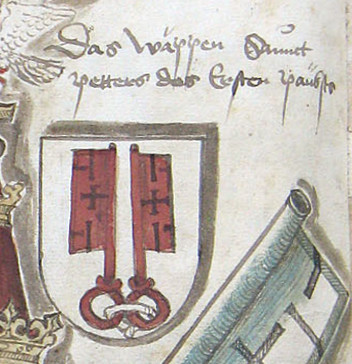
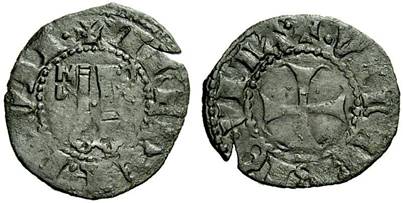
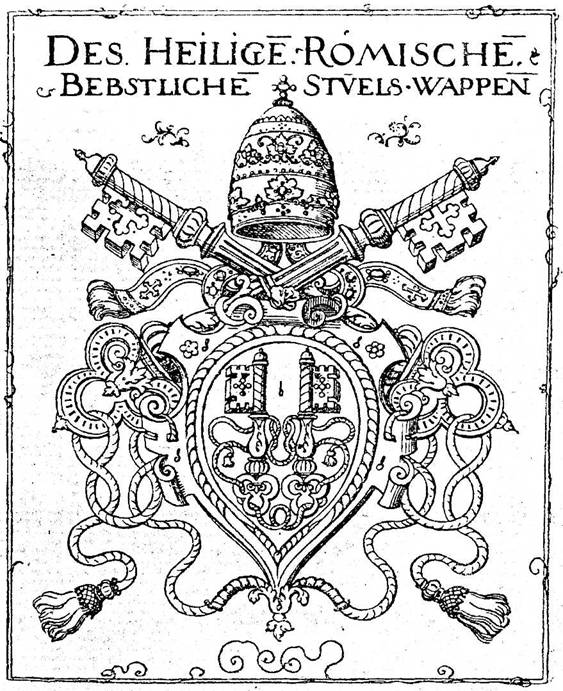
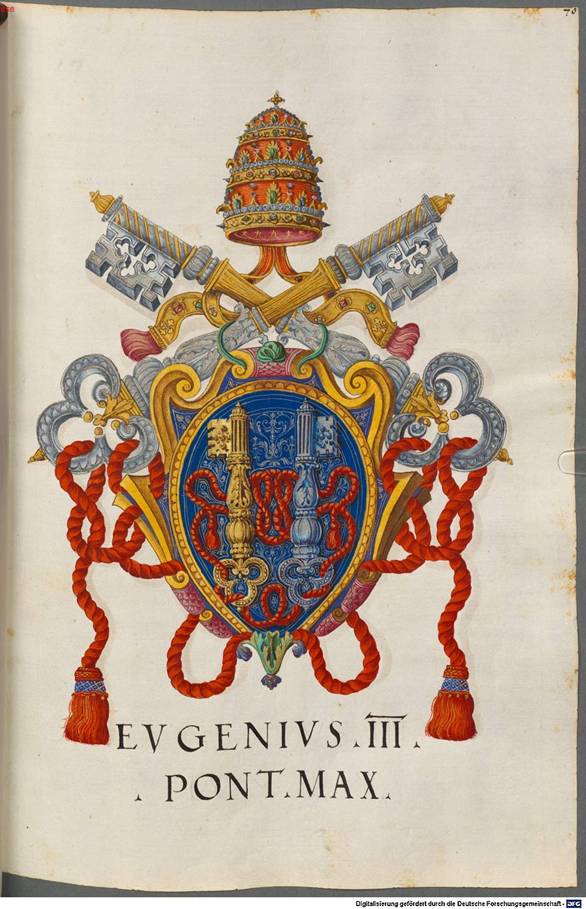
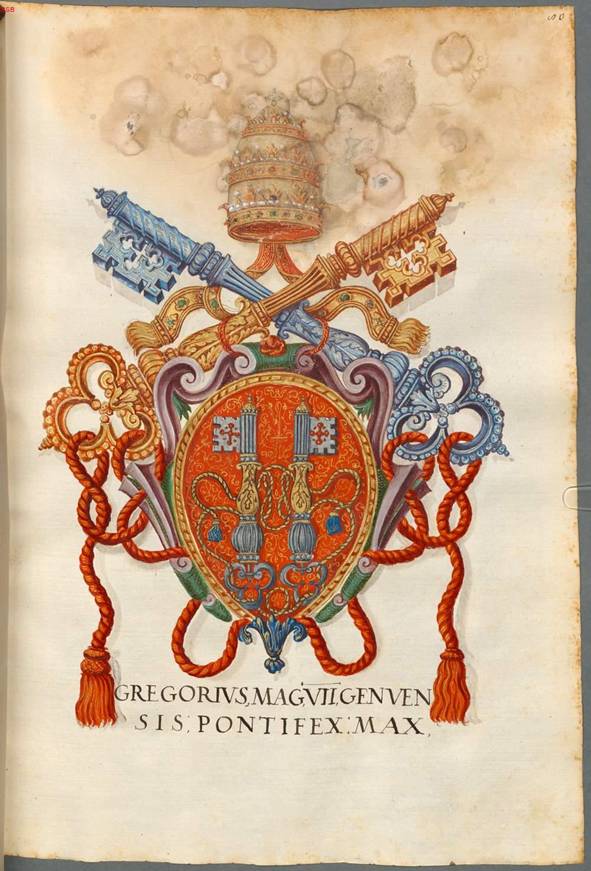
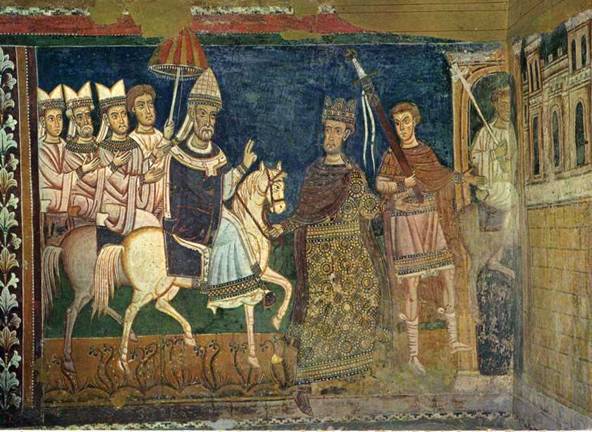
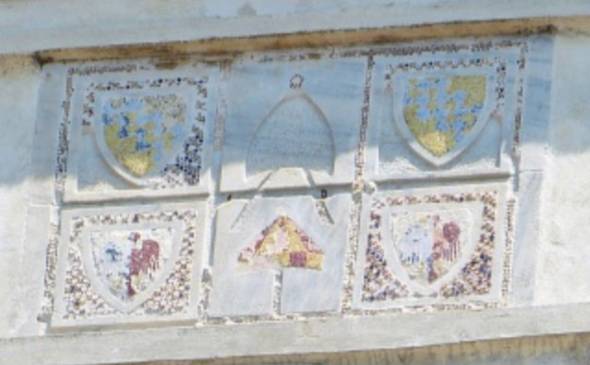
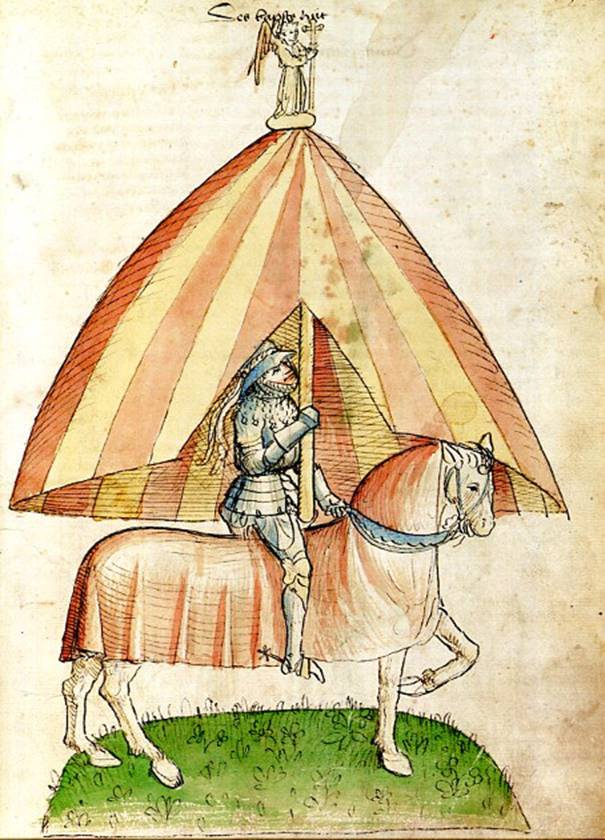
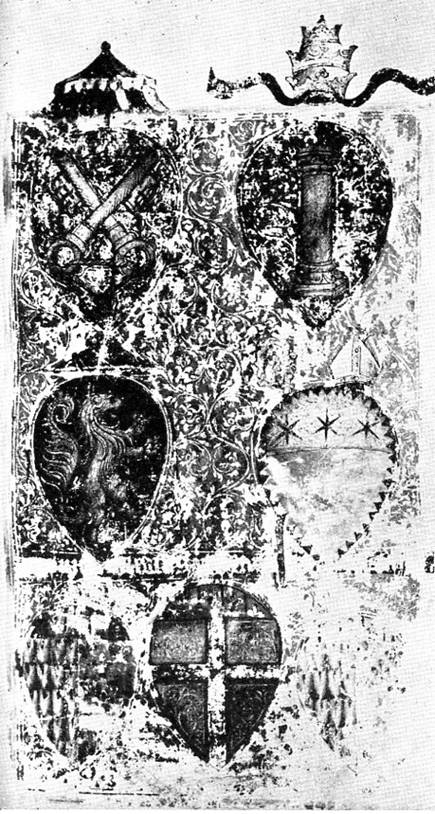
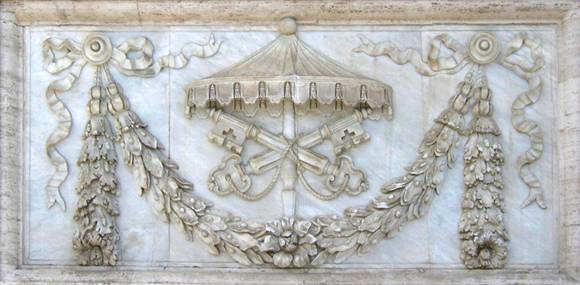
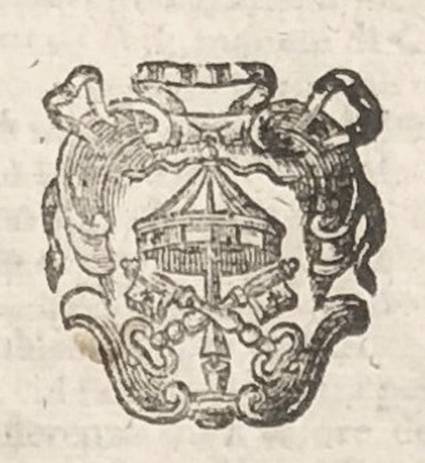
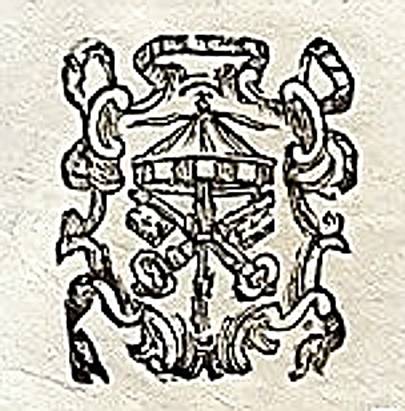

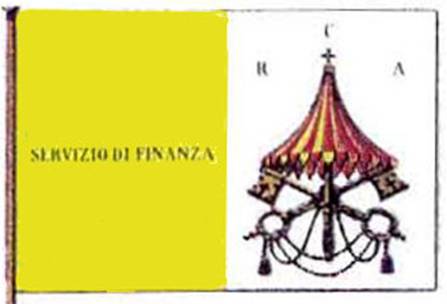
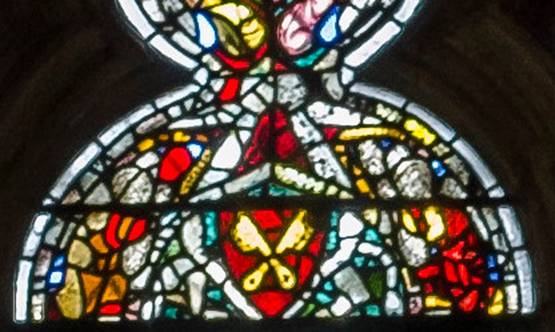
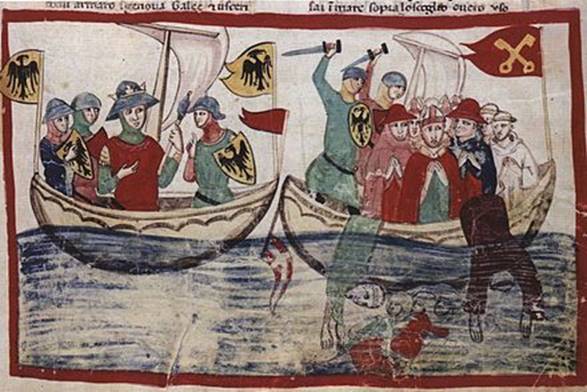
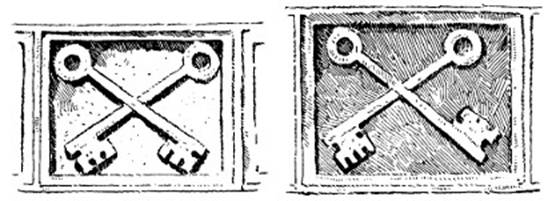
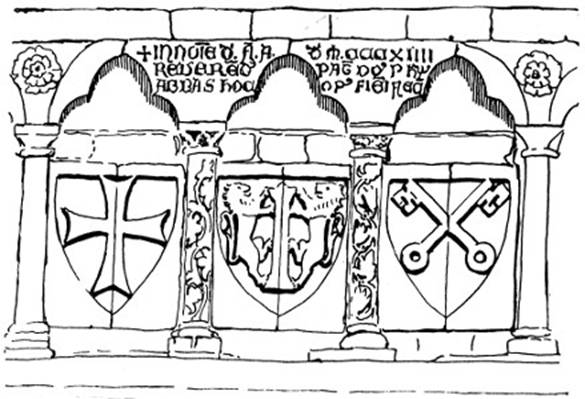
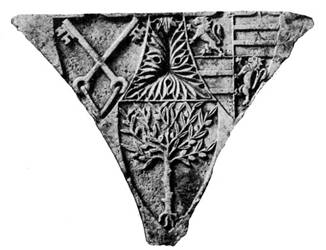
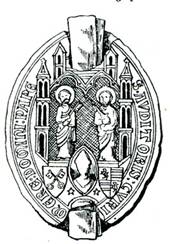
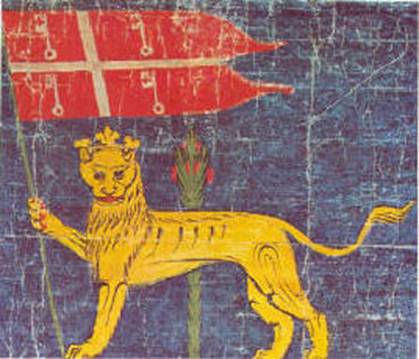
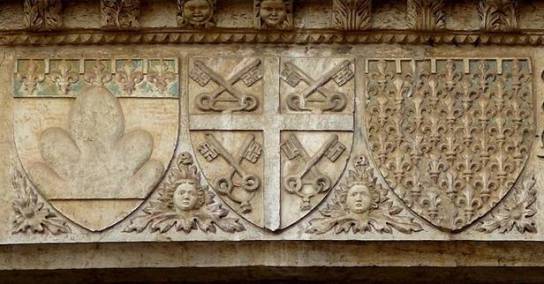
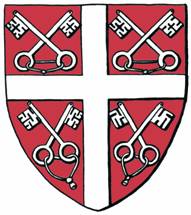
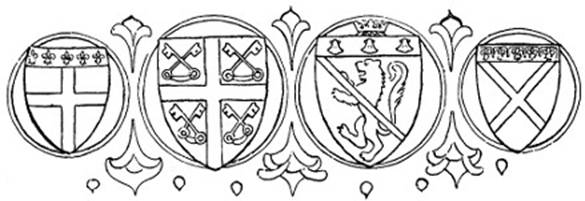
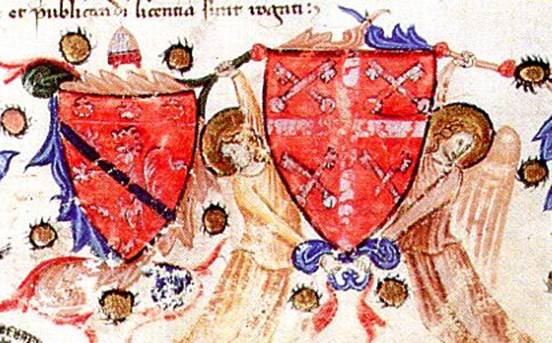
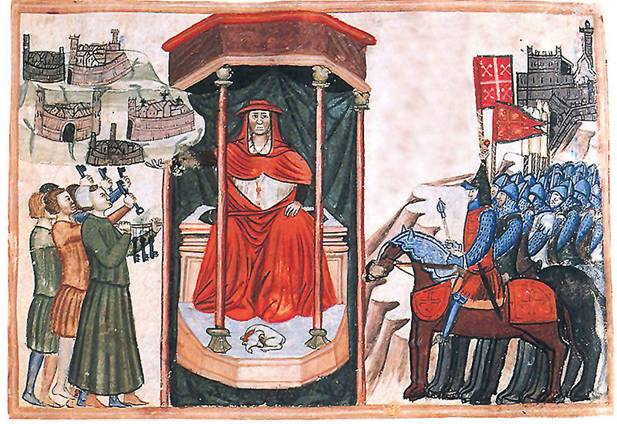
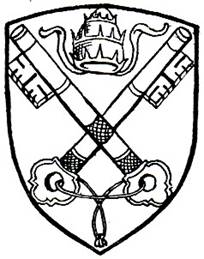

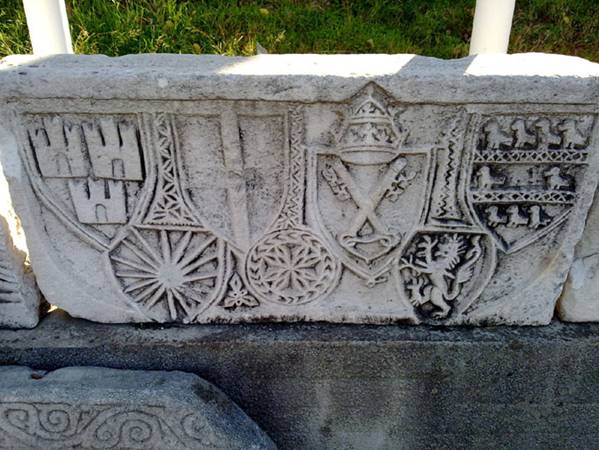
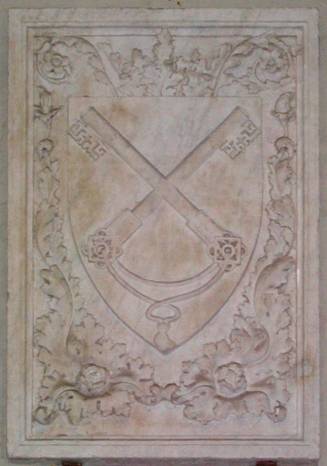
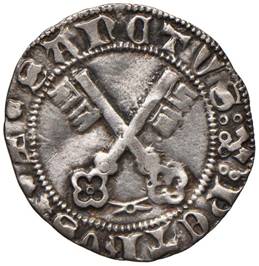
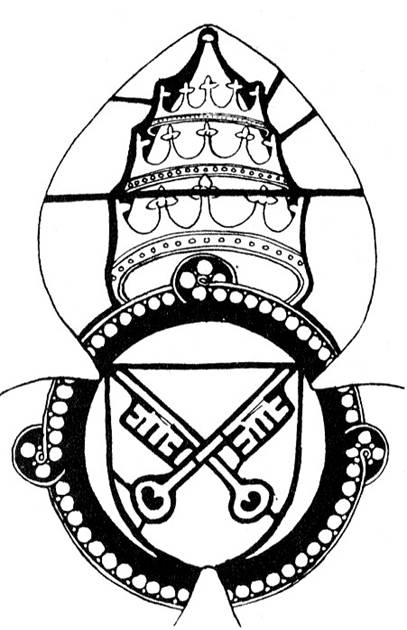
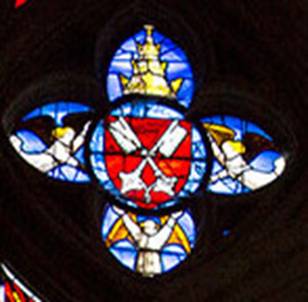
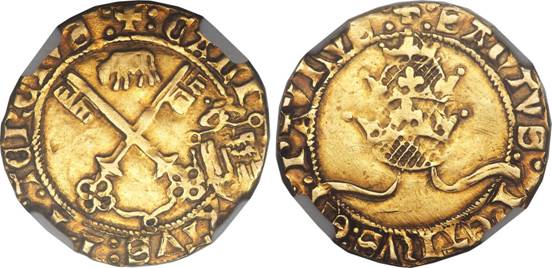
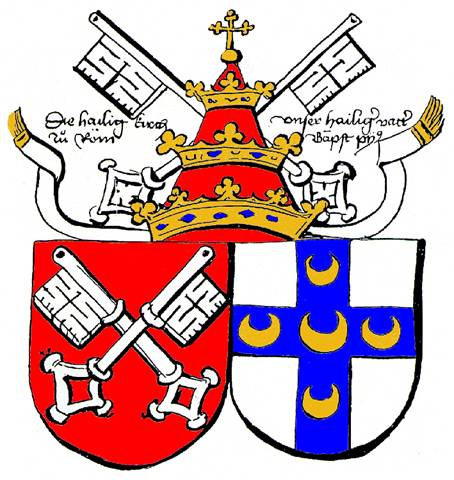
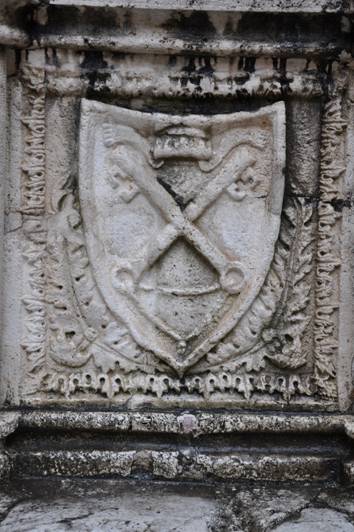
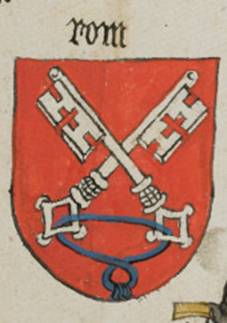
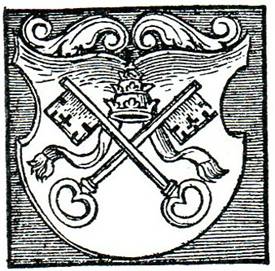
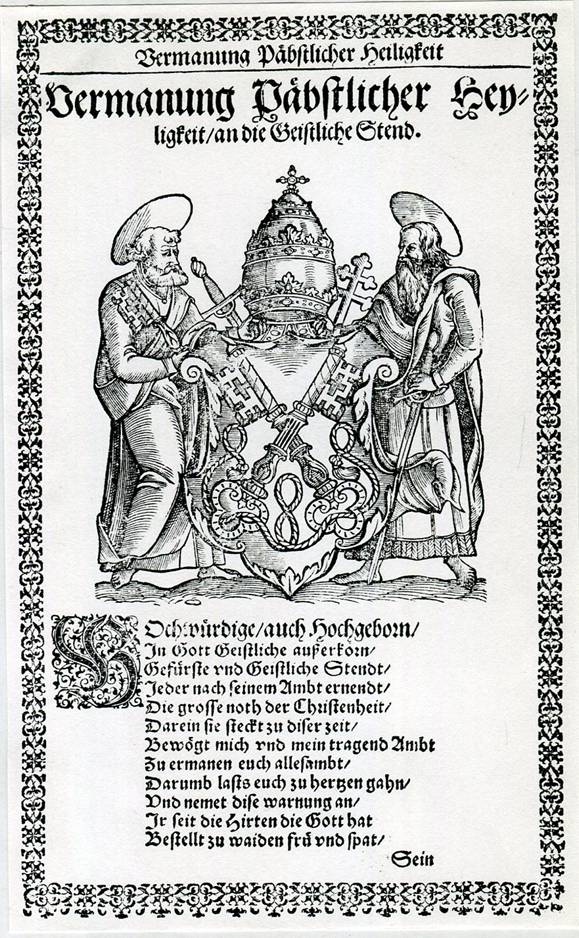
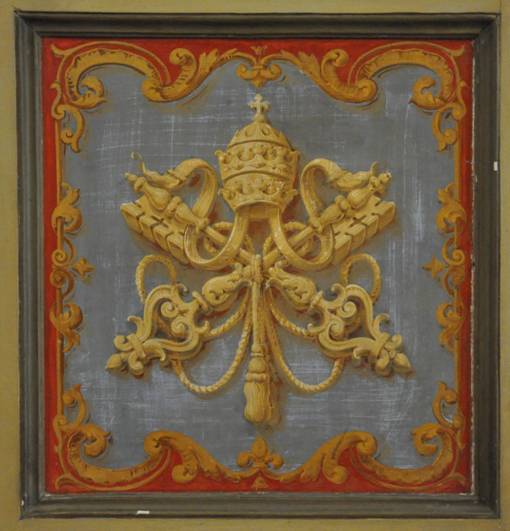
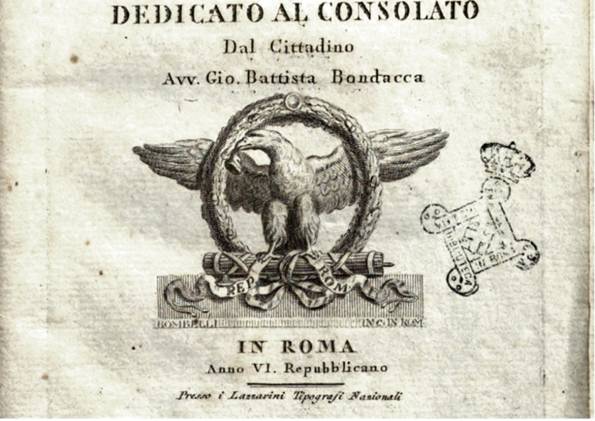
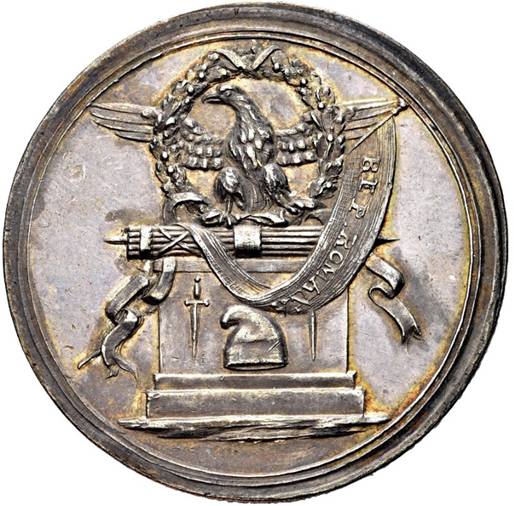
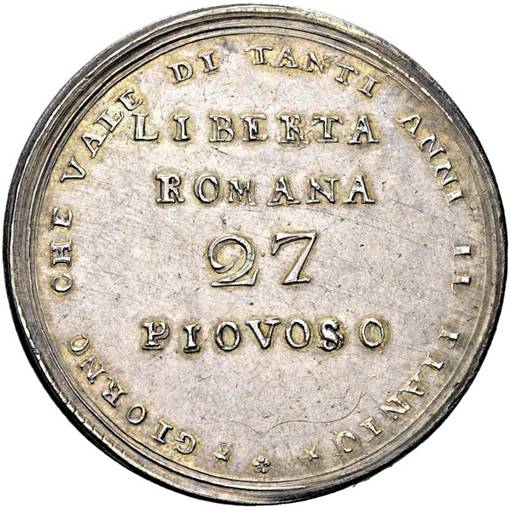
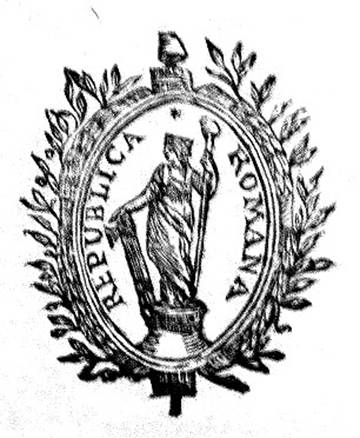
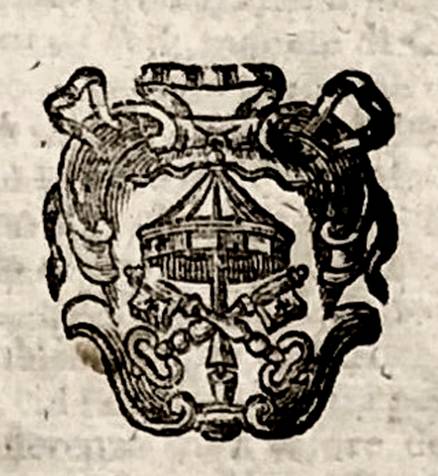
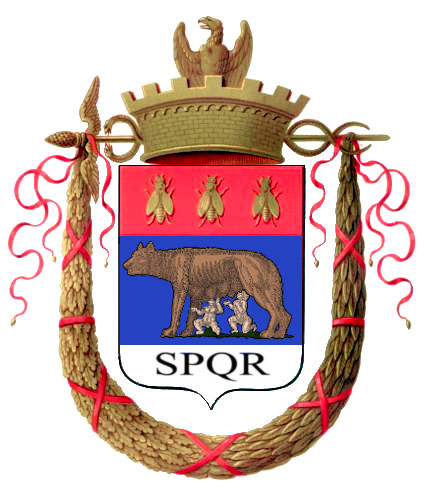
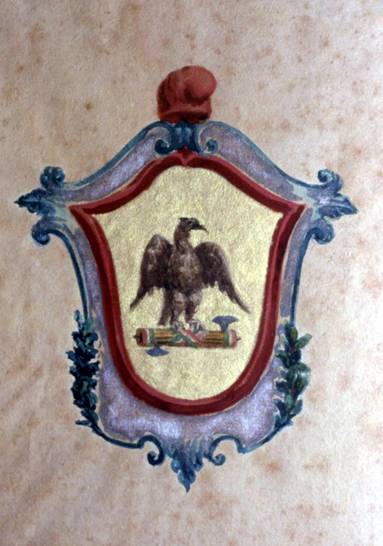
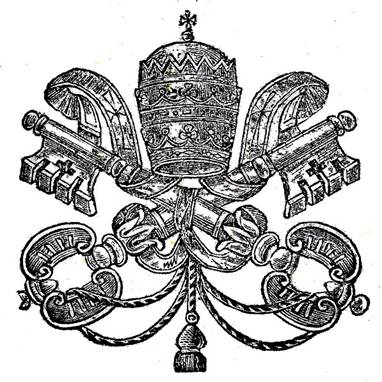
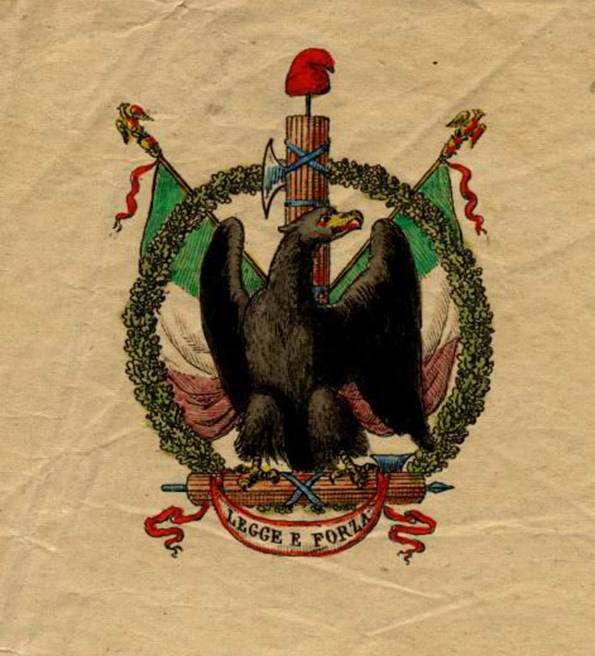
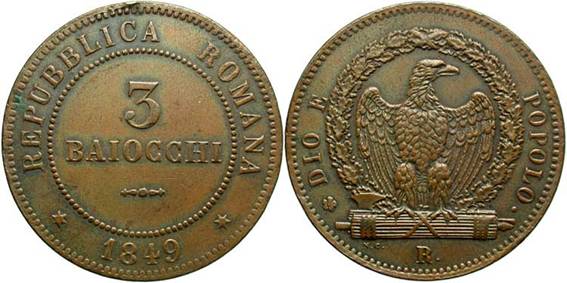
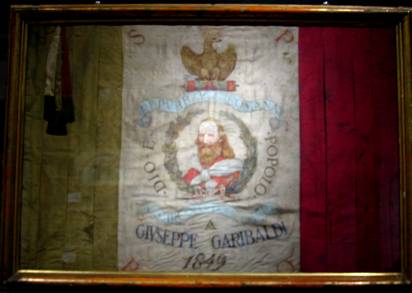
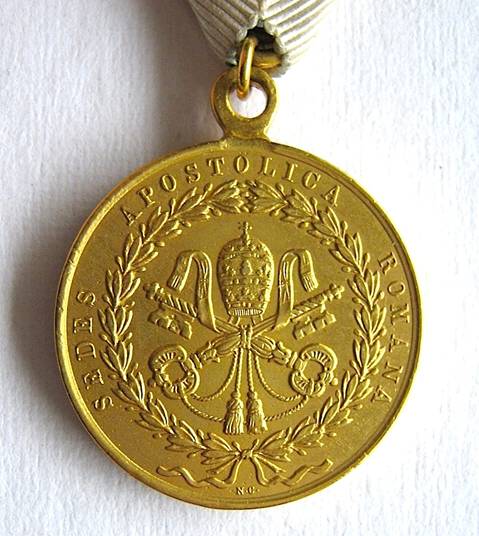
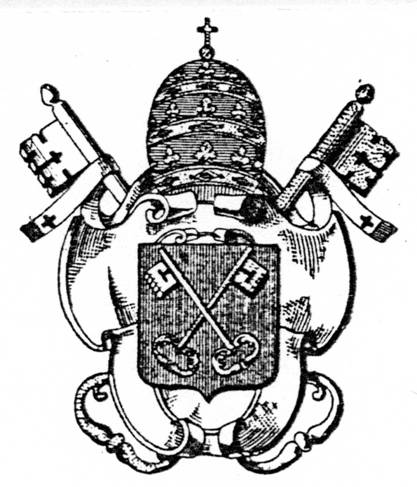
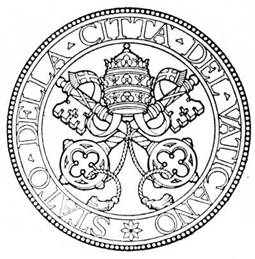
 Heraldry of the World
Heraldry of the World